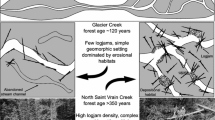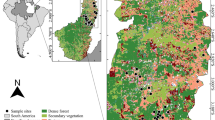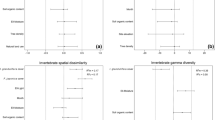Abstract
Removal of riparian vegetation and straightening of stream channels (channelization) are the most prevalent forms of habitat degradation in streams and their riparian zones. Both have direct effects on organisms in the habitats where they occur, but also have potential to cause indirect effects by interrupting the flux of invertebrate prey between the two adjacent ecosystems. We measured abundance of web-building riparian spiders along four types of streams in Hokkaido, Japan: relatively undisturbed streams, streams where riparian vegetation had been removed, previously channelized streams where the banks had revegetated, and streams that had been both channelized and had the vegetation removed. Spider abundance was reduced by 70% or more by either habitat disturbance alone, or both combined, and the number of spider families was also reduced. Spiders of the family Tetragnathidae, which specialize in capturing adult insects emerging from streams, were strongly reduced by either form of habitat degradation alone, or in combination. In contrast, abundance of spiders in other families that capture prey from both terrestrial and aquatic sources was reduced more strongly by vegetation loss than channelization. These results indicate that riparian vegetation loss has strong direct effects on spiders by reducing habitat for web sites. They also suggest that channelization can have strong indirect effects on riparian-specialist tetragnathid spiders, probably by reducing the flux of adult aquatic insects from the stream to the riparian zone.


Similar content being viewed by others
References
Allan JD, Flecker AS (1993) Biodiversity conservation in running waters. BioScience 43:32–43
Baxter CV, Fausch KD, Murakami M, Chapman PL (2004) Fish invasion restructures stream and forest food webs by interrupting reciprocal prey subsidies. Ecology 85:2656–2663
Baxter CV, Fausch KD, Saunders WC (2005) Tangled webs: reciprocal flows of invertebrate prey link streams and riparian zones. Freshwater Biol 50:201–220
Chikuni Y (1989) Pictorial encyclopedia of spiders in Japan. Kaisei-sha, Tokyo
Chutter FM (1969) The effects of silt and sand on the invertebrate fauna of streams and rivers. Hydrobiologia 34:57–76
Cloe WW III, Garman GC (1996) The energetic importance of terrestrial arthropod inputs to three warmwater streams. Freshwater Biol 36:105–114
Collier KJ, Bury S, Hibbs M (2002) A stable isotope study of linkages between stream and terrestrial food webs through spider predation. Freshwater Biol 47:1651–1659
Cordone AJ, Kelley DW (1961) The influences of inorganic sediment on the aquatic life of streams. CA Fish Game 47:189–228
Gregory SV, Swanson FJ, McKee WA, Cummins KW (1991) An ecosystem perspective of riparian zones. BioScience 41:540–551
Henschel JR, Mahsberg D, Stumpf H (2001) Allochthonous aquatic insects increase predation and decrease herbivory in river shore food webs. Oikos 93:429–438
Iwata T, Nakano S, Murakami M (2003) Stream meanders increase insectivorous bird abundance in riparian deciduous forests. Ecography 26:325–337
Kato C, Iwata T, Nakano S, Kishi D (2003) Dynamics of aquatic insect flux affects distribution of riparian web-building spiders. Oikos 103:113–120
Kawaguchi Y, Nakano S (2001) Contribution of terrestrial invertebrates to the annual resource budget for salmonids in forest and grassland reaches of a headwater stream. Freshwater Biol 46:303–316
Kawaguchi Y, Nakano S, Taniguchi Y (2003) Terrestrial invertebrate inputs determine the local abundance of stream fishes in a forested stream. Ecology 84:701–708
Meehan WR (ed) (1991) Influences of forest and rangeland management on salmonid fishes and their habitats. American Fisheries Society Special Publication 19, Bethesda
Murakami M, Nakano S (2002) Indirect effect of aquatic insect emergence on a terrestrial insect population through bird predation. Ecol Lett 5:333–337
Naiman RJ, Décamps H (1997) The ecology of interfaces: riparian zones. Annu Rev Ecol Syst 28:621–658
Nakano S, Murakami M (2001) Reciprocal subsidies: dynamic interdependence between terrestrial and aquatic food webs. Proc Nat Acad Sci USA 98:166–170
Nakano S, Miyasaka H, Kuhara N (1999) Terrestrial-aquatic linkages: riparian arthropod inputs alter trophic cascades in a stream food web. Ecology 80:2435–2441
Negishi JN, Inoue M, Nunokawa M (2002) Effects of channelisation on stream habitat in relation to a spate and flow refugia for macroinvertebrates in northern Japan. Freshwater Biol 47:1515–1529
Power ME, Rainey WE (2000) Food webs and resource sheds: towards spatially delimiting trophic interactions. In: Hutchings MJ, John EA, Stewart AJA (eds) The ecological consequences of habitat heterogeneity. Blackwell Science, Oxford, pp 291–314
Power ME, Rainey WE, Parker MS, Sabo JL, Smyth A, Khandwala S, Finlay JC, McNeely FC, Marsee K, Anderson C (2004) River to watershed subsidies in an old-growth conifer forest. In: Polis GA, Power ME, Huxel GR (eds) Food webs at the landscape level. University of Chicago Press, Chicago, pp 217–240
Sabo JL, Power ME (2002) Numerical response of lizards to aquatic insects and short-term consequences for terrestrial prey. Ecology 83:3023–3036
Sanzone DM, Meyer JL, Marti E, Gardiner EP, Tank JL, Grimm NB (2003) Carbon and nitrogen transfer from a desert stream to riparian predators. Oecologia 134:238–250
SAS Institute (1999) SAS Version 8e. SAS Institute, Cary
Vitousek PM, Mooney HA, Lubchenco J, Melillo JM (1997) Human domination of earth’s ecosystems. Science 277:494–499
Wallace JB, Eggert SL, Meyer JL, Webster JR (1997) Multiple trophic levels of a forest stream linked to terrestrial litter inputs. Science 277:102–104
Ward JV (1998) Riverine landscapes: biodiversity patterns, disturbance regimes, and aquatic conservation. Biol Conserv 83:269–279
Waters TF (1995) Sediment in streams: sources, biological effects and control. American Fisheries Society Monograph 7, Bethesda
Yoshida M (1989) Predatory behavior of three Japanese species of Metleucauge (Araneae, Tetragnathidae). J Arachnol 17:15–26
Acknowledgements
We thank Akane Uesugi, Kazuo Takahashi, and Kazuyoshi Tatara for help with field sampling, Tomoya Iwata for advice on sampling and assistance identifying spiders, and Masashi Murakami and staff and students at the Tomakomai Experimental Forest for logistical support. This research was funded by a grant from the U.S. National Science Foundation (NSF) to K.D.F. (DEB0108222), supplemented by a grant from the Research Experiences for Undergraduates program of the NSF.
Author information
Authors and Affiliations
Corresponding author
About this article
Cite this article
Laeser, S.R., Baxter, C.V. & Fausch, K.D. Riparian vegetation loss, stream channelization, and web-weaving spiders in northern Japan. Ecol Res 20, 646–651 (2005). https://doi.org/10.1007/s11284-005-0084-3
Received:
Accepted:
Published:
Issue Date:
DOI: https://doi.org/10.1007/s11284-005-0084-3




